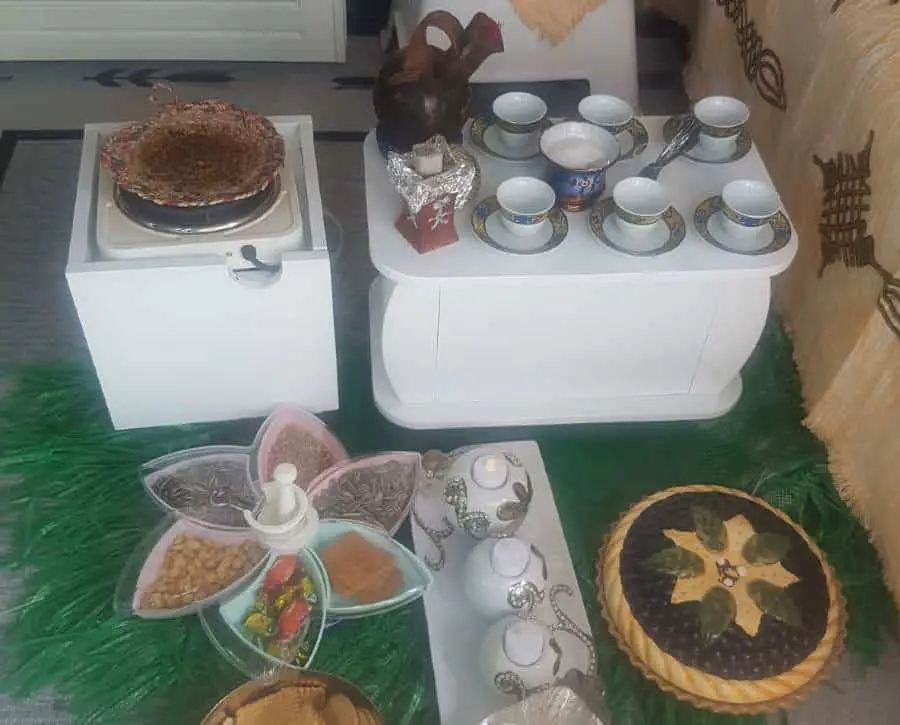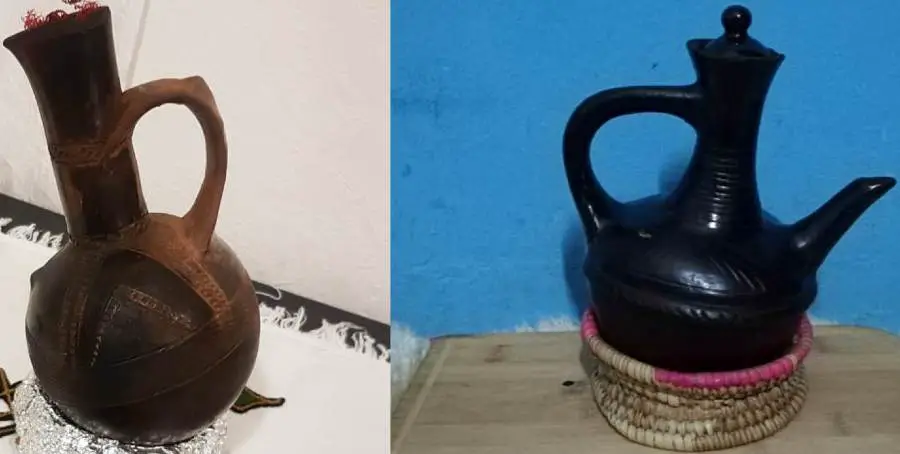
The coffee ceremony in Eritrea is similar to the traditional Ethiopian coffee ceremony. They both follow the same steps during preparation, serving, and drinking.
The similarities between the coffee rituals in Eritrea and Ethiopia come from the shared culture and heritage between the two countries. The people of Eritrean and Ethiopian heritage are commonly referred to as Habesha.
Consequently, both the Eritrean and Ethiopian coffee ceremonies are also referred to as the Habesha coffee ceremony or buna ceremony. Buna is coffee in Amharic.
The coffee ritual in both countries is a social event that fosters togetherness and sharing. Whether you live in the city or in a rural environment, the Eritrean coffee ceremony is an elegant and gratifying way to enjoy your drink with friends and family.
According to the Eritrean culture, this ceremony is conducted by a lady, usually the woman of the house. You can experience this ritual in Ethiopian and Eritrean restaurants, especially during celebrations.
Here are the steps to follow when making the Eritrean coffee ceremony.
Step #1 Assemble all the Materials and Equipment
Here are the items that you need when preparing the Habesha coffee ceremony
- green coffee beans
- incense
- pieces of coal
- fresh grass or an artificial grass mat
- snacks (such as popcorn and biscuits)
- Eritrean coffee set (rekebot, jebena, and coffee cups)
- a stove
- an iron skillet or shallow pan
- incense burner
- sugar bowl
Step #2. Prepare and Arrange the Eritrean Coffee Set
Spread the grass or mat over the area where you want to place the coffee set. Fresh flowers and grass release aromas that enhance the elegance of the ceremony.
You can replace the grass with any type of mat or no mat at all, an artificial grass mat mimics the fresh vegetation that is traditionally used in the ceremony.
Ensure that the whole area around the ceremony is tidy and everything is arranged neatly to enhance the positive outlook of the ceremony.
The Eritrean coffee set consists of a rekebot, a jebena with its stand, small cups and saucer plates, and a sugar bowl. The rekebot or traditional table is the focal point of the Eritrean coffee ceremony.
Identify the best position to place the rekebot and arrange the other items – a bowl of snacks, stove and incense holder – around it. Your seat should be on one side of the table and the guests on the other side. Arrange the cups and saucers on top of the rekebot
Step #3. Light The Stove and Burn Some Incense
Traditionally, a charcoal stove is the most ideal for the Eritrean coffee ceremony. However, you can also use an electric or gas stove depending on what is available to you.
Since you will burn incense throughout the ceremony, start burning some of it at the earliest stage to create a relaxed mood. Place one or two pieces of coal on the stove until they are red hot.
Shift hot coals to an incense burner and sprinkle some incense granules on the coal
Step #4 Roast Green Coffee Beans
Place the pan on the stove and spread some green beans on the pan. Continuously stir the beans or shake the pan to even the roasting and look out for some cracking sounds.
As the beans start to smoke and brown, they will release some gases, oils, and enchanting aromas. The beans will then start to pop or crack due to the pressure of gases that are trapped inside the beans. This is known as the first crack.
Then the beans continue to darken and release more moisture, aroma compounds, and carbon dioxide and enter into a second cracking phase.
If you want a light to medium roast, stop roasting before the second cracking. For a darker roast, continue roasting until after the second cracking.
Step #5. Show the Smoking Beans to the Guests to Savor the Aroma
Smelling the aroma of the roasting beans is an important aspect of the Habesha coffee ceremony. Carefully hold the pan with the hot smoking beans in front of every guest and the guest will fan some of the smoke towards their nose and body to enjoy the aromas. The smoke is also believed to drive away “evil spirits”
Step #6. Cool the Beans and Grind
Transfer the roasted beans to a cool dry pan or plate and leave them to cool. Meanwhile, invite the guests to enjoy some of the snacks as you all engage in banter and other discussions.
When the beans have cooled down, put enough beans in a grinder for the number of cups that you want to make and make a fine grind size. The amount of grinds to use is to your discretion depending on the number of guests and the strength of coffee that you desire.
Step #7. Brew the Eritrean Coffee
Put the grinds in the jebena and add enough water. Place the jebena on the stove to brew the coffee. The coffee is ready when it starts bubbling at the mouth of the pot. Carefully remove the pot from the stove and set it on its stand for the grounds to settle.
Step #8. Serve the First Cup
After about three minutes, tilt the jebena on its stand as if ready to pour the coffee to allow for the grounds to continue settling at the bottom. Leave it tilted for about 2 to 3 minutes.
Carefully pour the coffee into the cups without unsettling the grounds at the bottom and serve it to your guests. You can add sugar to the coffee before serving or have the guests add sugar for themselves. Some people prefer to add salt to the coffee instead of sugar. So, have some salt within reach.
Continue serving the snacks with the coffee. Customarily, the Habesha coffee ceremony involves three coffee servings.
Step #9 Brew the Second Serving
When the guests have drunk the first serving, add water to the grounds that are still inside the jebena and place the jebena on the stove to brew again. Collect the dirty cups and clean them before setting them on top of the rekebot.
When the coffee is brewed. Repeat the tilting maneuver with the jebena on its stand as the coffee cools down.
Serve the second cup without disturbing the grounds at the bottom of the jebena.
Step #10 Brew the Third Serving
Add water to the old grounds inside the jebena and brew another round. Clean the cups and serve the third round when the coffee has cooled enough.
Continue burning incense and offering the remaining snacks to the guests. The third cup is weak and is mainly drunk as a sign of respect to the guests and the hosts and to wish blessings to everyone who is partaking in the ceremony.

Wrap Up
Although the third serving is the last serving of the Eritrean coffee ceremony, you can still make new coffee with new grounds at any point within the ritual. Some people prefer using new grounds because the third serving is watery and very weak.
The Eritrean jebena is a bit different from the Ethiopian jebena: the Eritrean jebena has one opening whereas the Ethiopian has a separate inlet and a long-necked outlet. However, you can use either of the two.
Generally, it is easier to pour with the jebena that has a long neck without disturbing the coffee grounds.
Roasting raw coffee beans is an important part of the buna ceremony.
